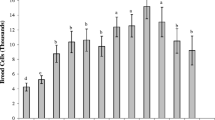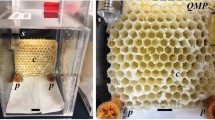Summary:
Crithidia bombi is a prevalent endoparasite of bumblebees that is transmitted both horizontally between and vertically within colonies of its host, the bumble bee Bombus terrestris, and to the next generation. By experimentally infecting or not infecting laboratory-raised colonies with a standard inoculum before their transfer to the field, this study was aimed at evaluating the level of virulence of C. bombi under natural conditions. However, an unexpected finding was a substantial and seasonal increase in infections of natural populations, such that all colonies quickly became infected once exposed to the field. On average, experimentally infected colonies showed positive signs of infection 9.5 days after being exposed, not different from the 11.7 days in untreated colonies. Not surprisingly therefore, no significant differences between the two experimental groups in measures of colony success, such as male and young queen production or time of emergence of sexuals, were found. Overall though, C. bombi showed low levels of virulence which fits recent models for parasites with correlated horizontal and vertical transmission rates. On the other hand, the number of sexuals produced depended on the length of time over which reproduction could be sustained. Thus, early colonies and those with large first brood and large maximum size were at an advantage. Also, strong effects of site occurred. In addition, many colonies became naturally infected with the microsporidian Nosema bombi. Such infections were not associated with experimental treatment or colony size, but correlated with an increased production of sexuals, particularly males.
Similar content being viewed by others
Author information
Authors and Affiliations
Additional information
Received 7 November 1997; revised 5 August 1998; accepted 10 September 1998.
Rights and permissions
About this article
Cite this article
Imhoof, B., Schmid-Hempel, P. Colony success of the bumble bee, Bombus terrestris, in relation to infections by two protozoan parasites, Crithidia bombi and Nosema bombi. Insectes soc. 46, 233–238 (1999). https://doi.org/10.1007/s000400050139
Published:
Issue Date:
DOI: https://doi.org/10.1007/s000400050139




